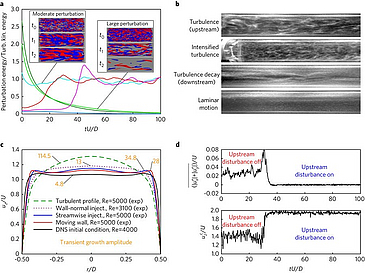J. Kühnen, B. Song, D. Scarselli, N. Burak Budanur, M. Riedl, A. P. Willis, M. Avila, B. Hof
Nature Physics (2018) 14, 386-390.
http://doi.org/10.1038/s41567-017-0018-3
Turbulence is the major cause of friction losses in transport processes and it is responsible for a drastic drag increase in flows over bounding surfaces. While much effort is invested into developing ways to control and reduce turbulence intensities, so far no methods exist to altogether eliminate turbulence if velocities are sufficiently large. We demonstrate for pipe flow that appropriate distortions to the velocity profile lead to a complete collapse of turbulence and subsequently friction losses are reduced by as much as 90%. Counterintuitively, the return to laminar motion is accomplished by initially increasing turbulence intensities or by transiently amplifying wall shear. Since neither the Reynolds number nor the shear stresses decrease (the latter often increase), these measures are not indicative of turbulence collapse. Instead, an amplification mechanism measuring the interaction between eddies and the mean shear is found to set a threshold below which turbulence is suppressed beyond recovery.


